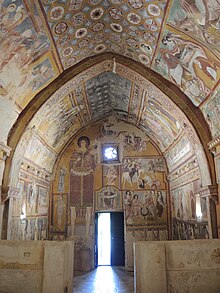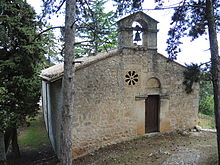| Oratory of San Pellegrino | |
|---|---|
| Oratorio di San Pellegrino | |
 Frescos Frescos | |
 | |
| 42°14′35″N 13°39′39″E / 42.243047°N 13.660833°E / 42.243047; 13.660833 | |
| Location | Bominaco (Caporciano) |
| Country | Italy |
| Denomination | Catholic |
| Website | http://www.comunecaporciano.aq.it/hh/index.php |
| History | |
| Status | Oratory |
| Architecture | |
| Functional status | Active |
| Style | Medieval |
| Completed | 1263 |
| Administration | |
| Diocese | Archdiocese of L'Aquila |
Oratorio di San Pellegrino (Italian for Oratory of San Pellegrino) is a medieval oratory in the village of Bominaco, in the municipality of Caporciano in the Province of L'Aquila (Abruzzo). The interior walls of the church are entirely covered in frescoes that represent a historical testimony of medieval Abruzzo. In 1902, the oratory was declared a national monument.
History
The oratory was part of a Benedictine monastery, Santa Maria Assunta, that was established in the Carolingian era. An inscription on the back wall indicates it was constructed in 1263, commissioned by Abbot Teodino. The oratory was believed to have been constructed over the tomb of San Pellegrino of Syria, a saint evidently highly regarded in this area, but little is known about him.
UNESCO declared the oratory a World Heritage Site in 1996.
Architecture
Exterior

An eighteenth-century porch marks the front facade, while a bell tower tops the back.
Interior

The small space (18.7 x 5.6m) comprises a single nave with ogival vaults in 4 bays. (Interior of Oratory) It is lit by three small windows on each side and rosette windows on the front and back facades. The space is divided by a half wall that must have served to separate lay visitors from the monks. The interior walls are entirely covered with frescoes, which date to the late 13th century.
Frescoes
4 rows of frescoes decorate the walls. At the lowest level are faux hanging curtains. Above, 3 rows of narratives represent scenes from the childhood of Christ, the Passion, the Last Judgment, the lives of St. Pellegrino and other saints, and months of the calendar. It has been suggested that a Charlemagne cycle was also included (now fragmentary). The apex of the vaults is covered with bands of geometric patterns. At least 3 different artists are thought to have produced the paintings, which owe a strong debt to Byzantine-Roman medieval traditions. Scholars have also noted a strong interest in lively naturalism in many of the frescoes, suggesting influences of northern Gothic art.
References
- "Oratorio di San Pellegrino" (in Italian). Regione Abruzzo. Archived from the original on June 17, 2016. Retrieved May 14, 2016.
- Mammarella, Luigi (1989). "Santa Maria di Bominaco". Abbazie e monasteri benedettini in Abruzzo (in Italian). Cerchio (AQ): Adelmo Polla Editore. pp. 138–139. ISBN 88-7407-026-8.
- Elenco degli edifizi monumentali in Italia (in Italian). Rome: Ludovico Cecchini. 1902. Retrieved 5 August 2021.
- "AFFRESCHI%2520ORATORIO%2520DI%2520SAN%2520PELLEGRINO". www.storiadellarte.com. Archived from the original on 2019-05-14.
- "AFFRESCHI%2520ORATORIO%2520DI%2520SAN%2520PELLEGRINO". www.storiadellarte.com. Archived from the original on 2019-05-14.
- Baschet, Jérôme.Lieu sacré, lieu d'images. Les fresques de Bominaco (Abruzzes, 1263) : thèmes, parcours, fonctions. « Images à l'appui » n° 5, Paris, éd. La Découverte-Ecole française de Rome, 1992, p. 101-106.
- Carli, Enzo. Arte in Abruzzo. Naples, 1998, p. 15-47; Della Valle, Mauro. "Osservazioni sui cicli pittorici di San Pellegrino a Bominaco e di Santa Maria ad Cryptas di Fossa in Abruzzo." ACME 59 (2006): 101-158.
- "Abruzzo Cultura - Scheda Pittura medievale - Provincia dell'Aquila". www.regione.abruzzo.it. Archived from the original on 2016-03-07.
External links
- "Affreschi. Oratorio di San Pellegrino" (in Italian). Regione Abruzzo. Archived from the original on June 17, 2016. Retrieved May 14, 2016.
- "Oratorio di San Pellegrino a Bominaco" (in Italian). Ministero dei beni e delle attività culturali e del turismo. Retrieved May 14, 2016.
- "Bominaco - San Pellegrino" (in Italian). Comune di Caporciano. Retrieved May 14, 2016.